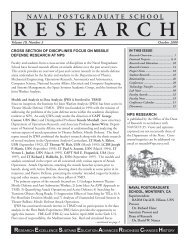Spectral Unmixing Applied to Desert Soils for the - Naval ...
Spectral Unmixing Applied to Desert Soils for the - Naval ...
Spectral Unmixing Applied to Desert Soils for the - Naval ...
Create successful ePaper yourself
Turn your PDF publications into a flip-book with our unique Google optimized e-Paper software.
However, <strong>the</strong> presences of BSCs are much more difficult <strong>to</strong> determine even<br />
utilizing Google Earth <strong>for</strong> virtual ground-truthing; <strong>the</strong> resolution is just not good enough<br />
<strong>to</strong> make a positive determination. Also, <strong>the</strong> expectation was that BSCs would be found in<br />
higher concentrations but <strong>the</strong> lack of large swaths of target material does not support this<br />
assumption, indicating that ei<strong>the</strong>r <strong>the</strong>re is minimal <strong>to</strong> no presence of BSCs or <strong>the</strong> spectra<br />
are not unique enough <strong>to</strong> be differentiated from <strong>the</strong> soil.<br />
4. Disturbed Creek Soil Endmember<br />
While <strong>the</strong> majority of this analysis focuses on <strong>the</strong> two data sets with <strong>the</strong> highest<br />
resolution, <strong>the</strong> lack of a substantial creek feature in <strong>the</strong> f110512t01p00r08 data set made<br />
it necessary <strong>to</strong> use <strong>the</strong> lower resolution 15.2 m pixel f110623t01p00r10 data set.<br />
Fortunately this larger data set had several creek features that could be analyzed using <strong>the</strong><br />
disturbed creek soil endmember <strong>for</strong> a repeatability test. Figure 36, insets A-C show <strong>the</strong><br />
results, which are somewhat similar <strong>to</strong> <strong>the</strong> camp road endmember in <strong>the</strong> initial<br />
f110512t01p00r07 data set (Figure 36, inset A-C). However, <strong>the</strong> f110623t01p00r10<br />
results were quite different than <strong>the</strong> camp road endmember (Figure 37). Similarly <strong>to</strong><br />
o<strong>the</strong>r results, <strong>the</strong> best identifications of target material are consistently within ranges<br />
between 9-16% with increasingly greater false positives <strong>for</strong> larger percentage pixel<br />
contributions.<br />
70
















